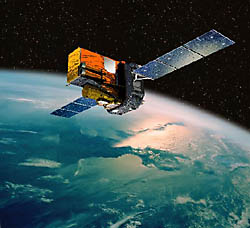HEASoft and XSPEC are now available as conda packages. See details ....
INTEGRAL
 The International Gamma-Ray Astrophysics Laboratory (INTEGRAL) of the European Space Agency was successfully launched on October 17, 2002. It was lifted off from Baikonur in Kazakhstan on a Russian Proton launcher and is now on a 72-hour elliptical orbit, ranging from 9,000 km up to 155,000 km from Earth. INTEGRAL is the successor of the ESA gamma-ray observatory Cos-B and the NASA gamma-ray Observatory CGRO. It is producing a complete map of the sky in the soft gamma-ray waveband and it is capable of performing high spectral and spatial observations in gamma rays. The observatory is also equipped with X-ray and optical detectors to provide simultaneous observations in these wavebands.
The International Gamma-Ray Astrophysics Laboratory (INTEGRAL) of the European Space Agency was successfully launched on October 17, 2002. It was lifted off from Baikonur in Kazakhstan on a Russian Proton launcher and is now on a 72-hour elliptical orbit, ranging from 9,000 km up to 155,000 km from Earth. INTEGRAL is the successor of the ESA gamma-ray observatory Cos-B and the NASA gamma-ray Observatory CGRO. It is producing a complete map of the sky in the soft gamma-ray waveband and it is capable of performing high spectral and spatial observations in gamma rays. The observatory is also equipped with X-ray and optical detectors to provide simultaneous observations in these wavebands.Mission Characteristics
Simultaneous Gamma-ray, X-ray and Optical observations.
- 2 Gamma-ray instruments
- Spectrometer (SPI; 20 keV - 8 MeV)
Coded aperature mask. FOV 16°, detector area. 500 cm2 (Germanium array) spectral resolution (E/dE) 500 @ 1 MeV, spatial resolution 2°.
- Imager (IBIS; 15 keV - 10 MeV)
Coded aperature mask. FOV 9° X 9°, detector area. 2600 cm2 (CdTe array) & 3100 cm2 (CsI array), spatial resolution 12´.
- Spectrometer (SPI; 20 keV - 8 MeV)
- Joint European X-ray Monitor (JEM-X; 3- 35 keV)
Coded aperature mask with 2 high pressure microstrip gas chambers.
FOV 4.8°, detector area. each 500 cm2, spatial resolution 3´. - Optical Monitoring Camera (OMC; 500-850 nm). 50mm lens with CCD.
FOV 5° X 5°.
* INTEGRAL artist’s view courtesy of ESA.
